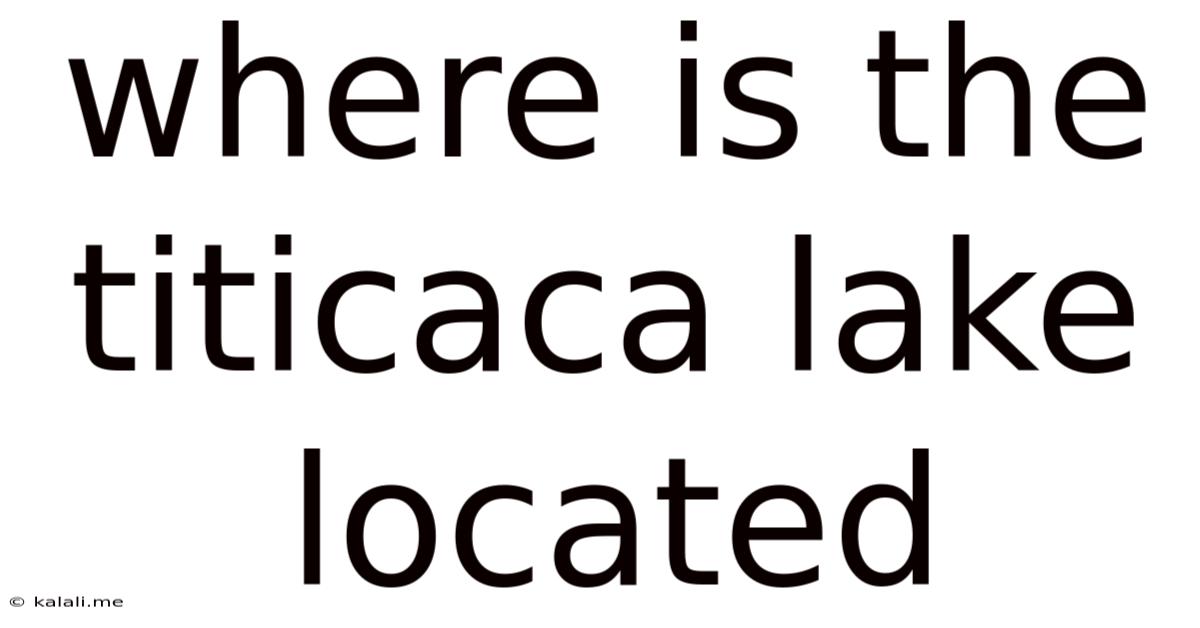Where Is The Titicaca Lake Located
Kalali
Jun 11, 2025 · 3 min read

Table of Contents
Where is Lake Titicaca Located? A Journey to the "Highest Navigable Lake in the World"
Lake Titicaca, often called the "Highest Navigable Lake in the World," holds a captivating allure for travelers and geographers alike. But exactly where is this magnificent body of water located? This article will delve into the precise location of Lake Titicaca, exploring its geographical context and highlighting its significance.
Lake Titicaca is situated high in the Andes Mountains, on the border between Bolivia and Peru. This shared location makes it a unique feature, belonging to both countries and reflecting the rich cultural heritage of both nations. Its location contributes to its unique ecosystem and the fascinating history and traditions of the people who live around its shores.
The Andes Mountains: A Dramatic Setting
The lake's location within the Andes Mountains is crucial to understanding its characteristics. Nestled at an impressive altitude of approximately 12,500 feet (3,812 meters) above sea level, it's a testament to the power of nature. This high altitude contributes to its cool climate and stunning views of the surrounding peaks. The dramatic landscape surrounding Lake Titicaca offers breathtaking vistas and opportunities for adventure activities like hiking and trekking.
Specific Countries and Regions
More specifically, Lake Titicaca straddles the border between two regions:
- Peru: The Peruvian portion of the lake primarily lies within the Puno Region, known for its vibrant indigenous culture. The city of Puno itself serves as a major gateway to the lake.
- Bolivia: In Bolivia, the lake is primarily located within the La Paz Department. The Bolivian side often offers a quieter, more off-the-beaten-path experience.
Navigating the Lake's Geography
Lake Titicaca is not a single, unified body of water. It's actually comprised of two main basins connected by a narrow strait:
- Lake Chucuito (or Pequeño Lago): The smaller, shallower basin.
- Lake Huiñaymarca (or Grande Lago): The larger, deeper basin.
Understanding this geographic detail is important when planning a visit, as different areas of the lake offer unique experiences and attractions.
Why is its Location Significant?
The location of Lake Titicaca is significant for several reasons:
- Cultural Heritage: The lake's location has fostered a rich and unique culture for centuries. Indigenous communities, particularly the Uros people with their iconic floating islands, have thrived on and around the lake for generations. Their traditions and way of life are deeply intertwined with the lake’s ecosystem.
- Biodiversity: The high altitude and unique climate have created a diverse ecosystem, supporting various plant and animal species found nowhere else on Earth. The lake is a vital habitat for many birds and fish.
- Tourism: Its spectacular location and cultural significance make Lake Titicaca a popular tourist destination. Visitors can explore the lake by boat, visit the Uros islands, and experience the vibrant culture of the surrounding communities.
In conclusion, Lake Titicaca's location high in the Andes Mountains, straddling the border of Peru and Bolivia, is integral to its unique character. Its geographical features, cultural richness, and biodiversity make it a truly remarkable place to visit and study. Understanding its precise location helps appreciate the natural beauty and cultural significance of this "Highest Navigable Lake in the World."
Latest Posts
Latest Posts
-
How Much Does A Sandwich Bag Weigh
Jul 01, 2025
-
I Wanna Go Where The Thunder Dont Roar Lyrics
Jul 01, 2025
-
One Onion Equals How Much Onion Powder
Jul 01, 2025
-
How Many Liters Is A Bottle Of Water
Jul 01, 2025
-
If I Am 16 What Year Was I Born
Jul 01, 2025
Related Post
Thank you for visiting our website which covers about Where Is The Titicaca Lake Located . We hope the information provided has been useful to you. Feel free to contact us if you have any questions or need further assistance. See you next time and don't miss to bookmark.